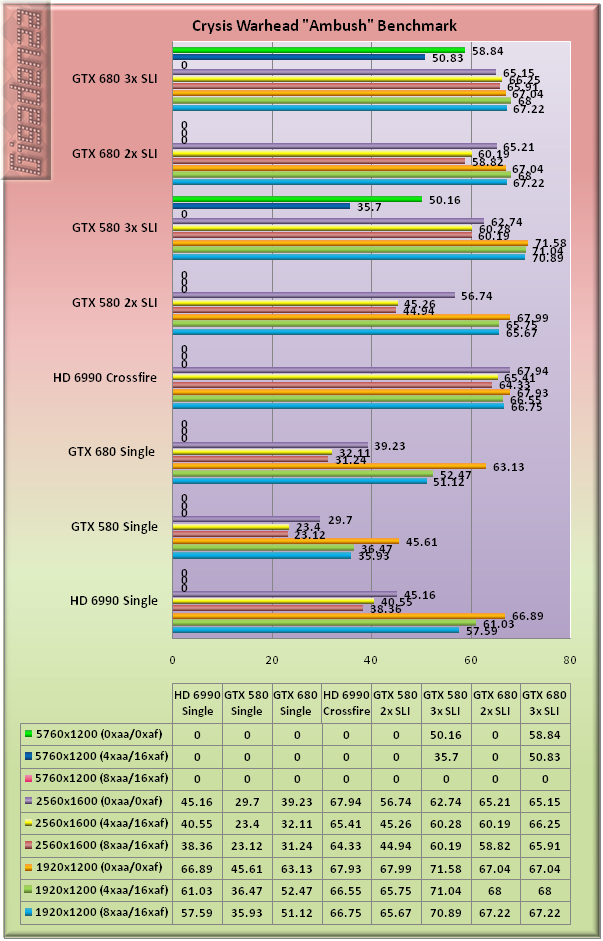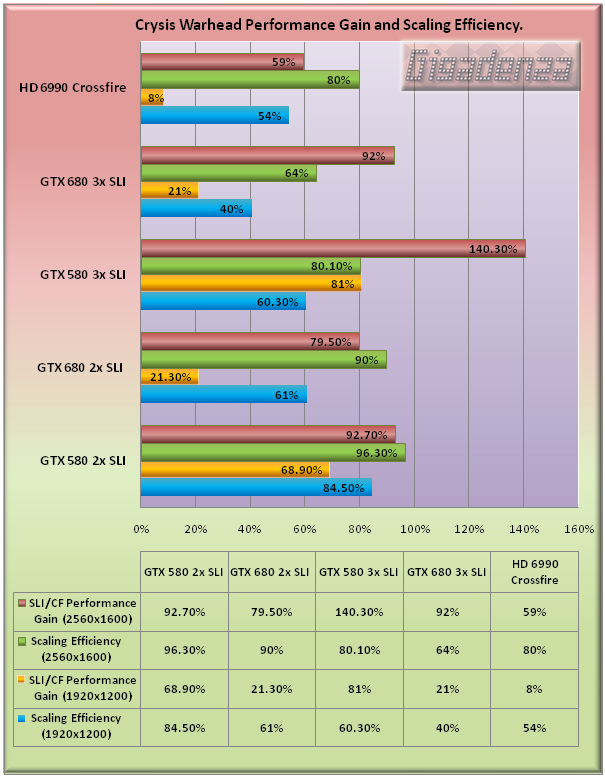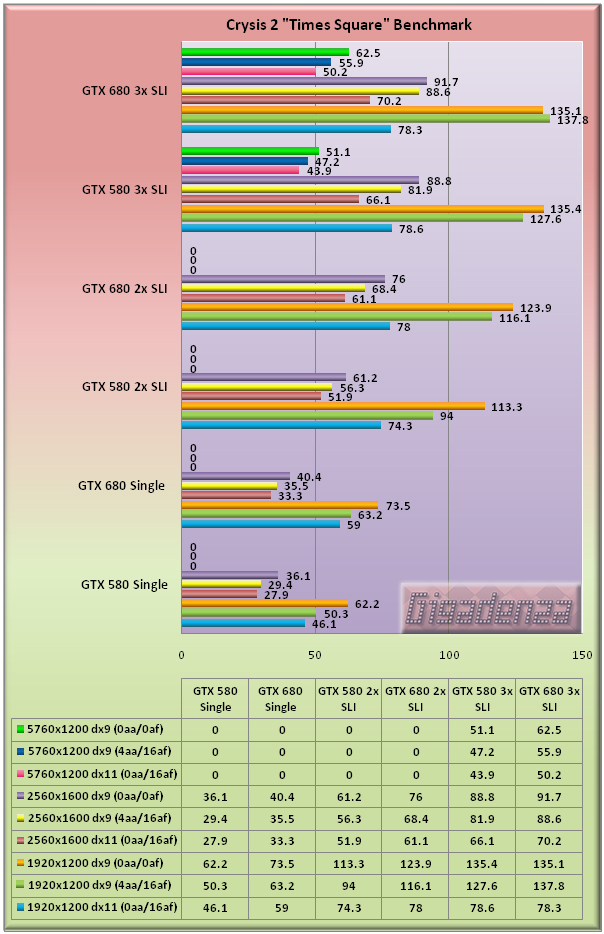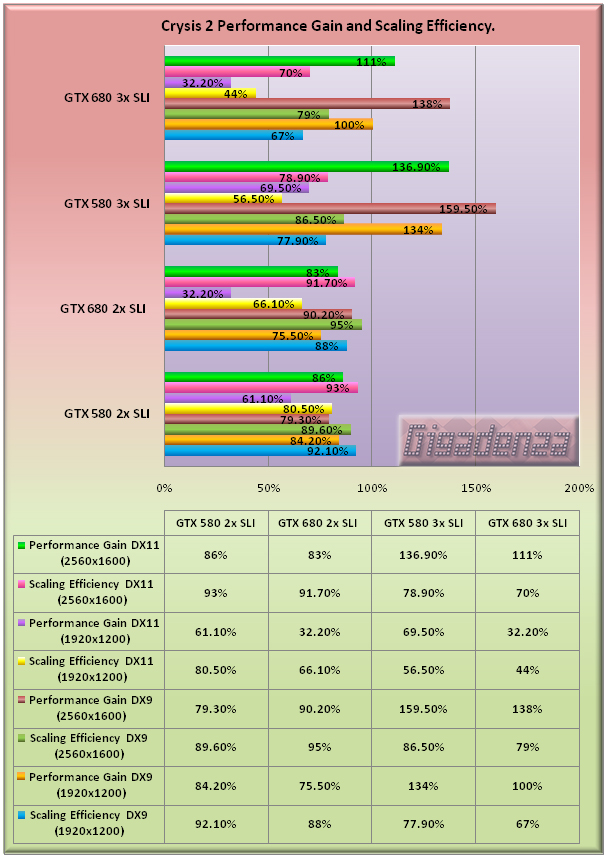The “Kepler” Rides Out – The Benchmarks.
Test 3 – Crysis Warhead.

As the slicker, better looking and less bug ridden follow up to Crysis – a game which became infamous for bringing the most explosively powerful PCs to their knees – Crysis Warhead is one of only two directX 10 titles to feature in this review. Using version 0.40 of the Framebuffer Benchmark Tool, 3 loops of the “Ambush” run were completed in each test.
Once again, it would appear that the lower resolution of 1920×1200 will only force a single card to break sweat. A much better showing from the 6990 here, which moves ahead of the 680 and increases its lead when we switch to 2560×1600.
In SLI and Crossfire, no matter how much eye-candy we apply at 1920×1200, all three cards hit a brick wall (in the form of the CPU) at around 67-70 frame per second. The 6990s in Crossfire continue to impress, retaining a lead over both pairs of Nvidia cards – albeit a very narrow one in the case of the 680s – and exhibiting virtually no loss of pace at 2560×1600 irrespective of quality. In fact, the big red cards are only just pipped by three 680s at this resolution, though the latter would almost certainly have responded more positively to a faster or overclocked CPU. Oh! And look. The performance of two 680s is once more, virtually equal to that of three 580s.
On the triple screen tests there was an issue, namely that neither the 580s or 680s were able to run the benchmark with anti-aliasing set to 8x. Any attempt to do so resulted in a crash to desktop with an error message. I tried loading the game normally, then loading a saved game (after setting aa to 8x in the options menu), same result. Driver problem? Memory leak? Who knows? Still, at least there was some data to go on. Both 3 way setups managed average frame rates above 50fps at 5760×1200 with 0xaa while the 680s continued to do so with 4xaa.

The scaling results show that the only significant benefit at 1920×1200 comes from adding a second 580, which returns a 69% performance increase. By contrast, a second 680 gives a pathetic 21% boost while pairing up the 6990 yields an almost laughable bonus of just 8%. Adding a third 580 raises the bar by just 12%, while a third 680 does nothing but twiddle its thumbs, no increase whatsoever and scaling inefficiency to match!
Climbing to 2560×1600 gives all three two card setups plenty to think about but when it comes to TRI-SLI the 580s scale better than their successors, thereby confirming the CPU as the cause of the metaphorical traffic jam.
Crysis Warhead - Dual GTX 680 vs. Dual GTX 580
Get the Flash Player to see this player.Test 4 – Crysis 2.

Crytek came under much criticism when it decided to release its hugely anticipated sequel bereft of support for Direct X 11, despite other major titles readily adopting it. Not much time passed before a beefy high resolution texture pack and an update exploiting DX11’s full compendium of features had made their way on to Steam’s servers. Both of these updates were installed prior to running this benchmark.
The “Adrenaline Crysis 2 Benchmark Tool” (v 1.0.1.13) was used to run three loops of the “Times Square” test with the quality set to “ultra” and “High res” textures enabled. In the tests where AA was set to 4x, “Edge AA” was set to “Edge Blur”.
As there was no option to apply 8x AA, the high quality test was run in with DirectX 11 enabled while the low and mid-quality runs were completed in DirectX 9 mode. It is not possible to enable AA in any form when running the game with DirectX 11 enforced, hence only one test was conducted at each resolution.
No chance to test the 6990 here I’m afraid, so this round becomes a straight fight between the two Nvidia cards. It’s scarcely surprising that the 680 bests its older sibling in single and two way SLI, though on this occasion, the gap is perhaps less substantial than expected, especially at 2560×1600. Adding a third card serves as proof of another interesting pattern, namely that scaling appears to be far more effective in the DirectX9 tests.

And here is further proof. Note in particular the performance gain at 1920×1200 when running two 680s, only 32.2% in the DX11 test but 75.5% in the equivalent directX9 tests, over twice the increase. Then look at what happens when we add a third 680, the gain for direcX 11 at 1920×1200 is utterly non-existent, we’re stuck at 32.2% yet with directX 9 at the same resolution, we get a 100% gain, that’s 25% higher than with two cards, not much but certainly better than nothing.
Moving to 2560x1600 yields vastly improved scaling for two way SLI in DirectX 11 and a performance gain reflecting that observed in DirectX 9, though in three way SLI, scaling is once again superior with the latter. Could this mean that Cryris 2 in its newer and apparently more graphically taxing guise is, in fact, placing a greater demand on the CPU and giving rise to yet more bottleneck-ridden frustration?




